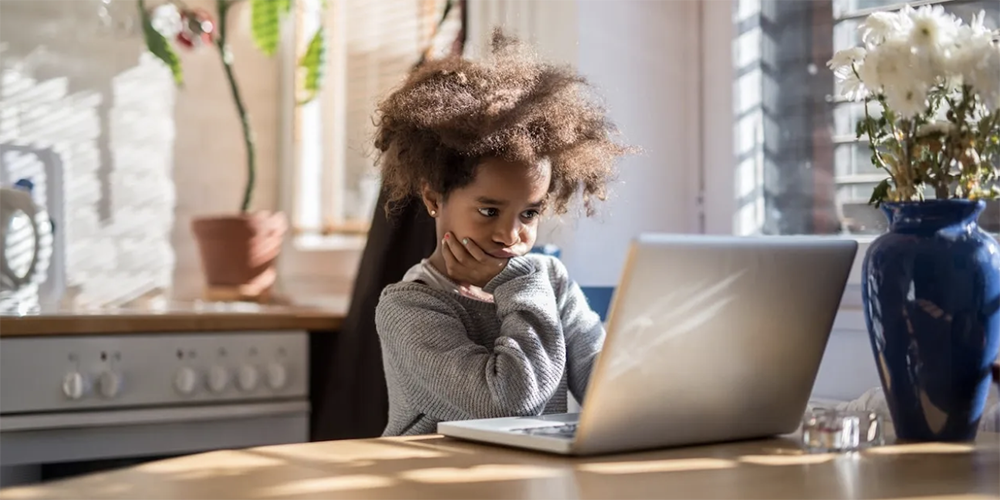
By Lise Ragbir, writer, curator, and Director of the Art Galleries at Black Studies at the University of Texas at Austin
As the United States loosens coronavirus-related restrictions, some of us are beginning to look up from where we are, to look ahead. We have undoubtedly entered a new era of looming unknowns and new normals, from record unemployment to face masks—an era to be further shaped by our youngest generation. As such, we’d be wise to consider what today’s children can tell us about the future.
I’m a Gen Xer with a 7-year-old. Since March, I’ve been a stay-at-home-working-mum-home-schooler and have spent unprecedented time with my (occasional) bundle of joy. Accordingly, I’ve learned that I’m a terrible math teacher, I should lock the door when I’m on a Zoom call, and I should have appreciated the precious alone time on my morning commutes.
This pandemic re-emphasizes the ways in which global tragedy can draw clear markers between one generation and the next.
My daughter, on the other hand, has learned to whip around an iPad, make her own lunch, and negotiate, well, everything—from the length of “recess” to extended bedtimes. And she’s not alone in her expedited learning. A friend of hers was bored enough in quarantine to learn all the states, and provinces of Canada, along with their respective capitals. Another friend learned to do his laundry. But perhaps more significant than who’s learned what during this unprecedented time is how the pandemic is shaping these young lives.
According to a Pew Research Center report on generational analysis, “An individual’s age is one of the most common predictors of differences in attitudes and behaviors.” So what we see our children doing today could offer valuable insight into the future.
A generation generally refers to groups of people born within a 15- to 25-year span. Coincidentally, it appears that generations are also marked, and even defined, by historic events. The so-called Greatest Generation, those born before 1928, identify with the Great Depression. The Silent Generation, born between 1929 and 1945, grew up during wars and economic depression. The baby boomer generation, born between 1946 and 1965, is so-called for the post-World War II population spike. Generation X, born between 1965 and 1980, saw the impeachment of Nixon, Roe v. Wade, and the growing environmental impact of capitalism. And millennials, born after 1980, grew up with Reaganomics, 9/11, and the 2008 financial crisis.
This generation now collectively understands that one’s daily existence can change overnight.
As a Black woman, that the marking of generations began after enslaved Africans stopped being traded throughout the Americas is not lost on me. That those unheard voices will never factor into to these historical measures of culture, philosophy, and achievement is a despicable truth. And yet, I trust that as this modern convention evolves, future cohorts will take into account those from the past who have not been heard.In 2020, we are witnessing the early development of the new generation. According to Pew, many have started calling those born after 1997 Gen Z. Others call them Zoomers. But like world wars, or the Great Depression, this pandemic re-emphasizes the ways in which global tragedy can draw clear markers between one generation and the next. As such, a new name might be given to this generation as the coronavirus pandemic has disrupted the world they knew. Those born 25 years after 1980 now have real-life proof that just because parts of life are routine, it doesn’t mean it will stay that way. It’s true: Every generation has those who know that nothing lasts forever. But this generation now collectively understands that one’s daily existence can change overnight. It’s not merely about the uncertainty of one day to the next, but more so how this new collective knowledge will affect generational attitudes.
I was an ’80s teenager, but I’d be lying if I said I totally get those who were born after 1980. Millennials, in many ways, seem to have grown up light years beyond my own childhood—which might be why I find myself trying to understand ensuing generations. And for all the ways that millennials are a wonder to me, if I pay attention, I might perhaps stand a better chance of understanding the generation coming after them.
When I picture a future version of my daughter and her peers, observation, more than a desire for prophecy, prompts these 10 imagined truths and accompanying questions. As I see it, those in this new generation:
- Won’t trust that things will be the same from one day to the next. What will this do to their sense of security?
- Won’t know the term “germaphobe” (because they will all be germaphobes.) Will this mean they’ll never know the layered meaning of a handshake?
- Will believe that meaningful connections can be made virtually. If FaceTiming with a friend who lives thousands of miles away replaces going to the mall, how will group politics change?
- Will trust that “learning” can happen anywhere—and anyone can teach (though not all to the same standard.) How will this affect institutionalized education?
- Will know how to celebrate, or mourn, without physically convening. Will the ways in which we honor life’s milestones trigger new technologies? And how will new technologies affect our social rituals?
- Will understand the reality of having and having not. Will commonplace “riches-to-rags” stories level socioeconomic playing fields?
- Will possess a flight anxiety that has nothing to do with a fear of falling from the sky. (Shoe removal will be a minor inconvenience compared to the new reality.) Will they travel less, or develop a bubble-ized wanderlust?
- Will have a heightened comfort with, and respect for, solitude. Will this “downtime” lead to higher rates of innovative problem-solving and heightened emotional awareness?
- Will see front-line and essential workers as heroes. (The notion that a blue-collar job was ever considered less than a white-collar might seem laughable.) How will this affect efforts to achieve social and economic equality?
- Will blame those from previous generations for not caring sooner, for not paying enough attention to the signs. And we will agree.
As a parent who wants to believe my child holds a bright future, I imagine hers to be a generation of creative problem-solvers (I draw this hope from watching her make dragons from toilet paper boxes when we’re too preoccupied to entertain her.) I imagine her generation will have an appreciation for homegrown and DIY efforts from planting vegetable gardens and self-done haircuts. And while social-distancing might spawn a comfort with solitude, the distance from each other might also create a generation that appreciates the value of community, more than any other.
If current shortages continue, I imagine we might see fewer meat eaters and more bread makers (or we might be seeing the beginning of a gluten-intolerant generation.) I imagine, after the economic fallout from this pandemic, that this generation might be comfortable trading a sourdough loaf for garden-fresh produce, or hand-sewn masks for the extra cleaning supplies that were accidentally delivered via the virtual market. And they might find a new alternative to a failing economic system. Maybe these 5-year-old laundry-doers will be known as the “Masked Generation”—for the fabric that they strap to their faces, but also for the ways in which they’ll have to protect themselves from a range of a new era’s unknowns. Or maybe, the kid that once said, “I hate coronavirus” daily will be part of the “Crowned Generation”—for “corona” but also for the ways in which they might be lauded for finding solutions to issues that have plagued society for centuries. Or these kids might be known as members of the “Distanced Generation,” because of the social-distancing reality, but also for the ways in which they’ll distance themselves from the mistakes of past generations. I say this with hope.
This article was originally published on Yes! Magazine.
